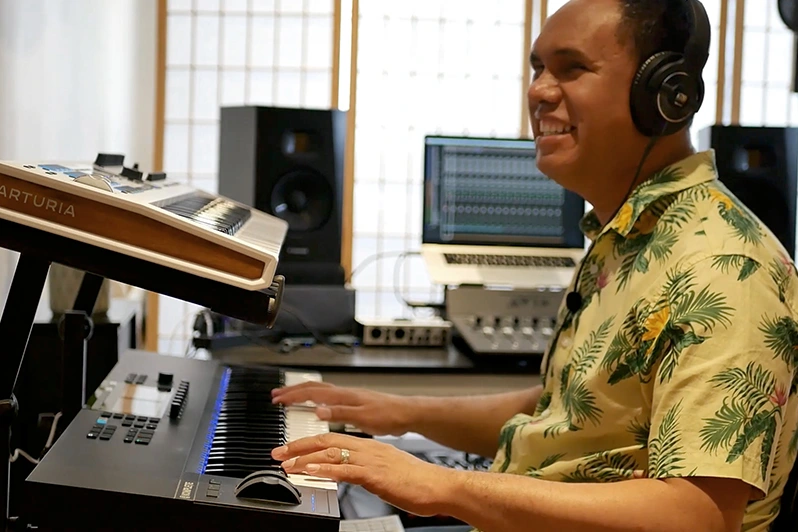Introduction
Art has traditionally been considered a visual form of expression, but for low-vision artists, it extends far beyond sight. By utilizing touch, sound, and other senses, these artists challenge traditional artistic boundaries, offering new perspectives and experiences for audiences. This article explores how low-vision artists express their creativity through multi-sensory approaches, breaking the limits of traditional art and inspiring new forms of expression.
Multi-Sensory Creations in Low-Vision Art
Success Stories of Low-Vision Artists
Keith Salmon: Painting Landscapes by Feeling
Keith Salmon, a British visual artist, uses his remaining peripheral vision and tactile techniques to create abstract landscapes. His experience as a hiker in the Scottish Highlands, where he often gathers inspiration, adds depth to his works, despite his limited sight. Salmon compensates for his low vision by using touch as a primary tool for navigating his canvas. This tactile method allows him to feel the surface of his work as he paints, helping him maintain control and coherence in his abstract depictions of nature.

(Hidden Compass, n.d.)
Through texture and touch, Salmon creates pieces that evoke a powerful sense of place, blurring the boundaries between visual art and physical sensation. His works invite audiences, both sighted and visually impaired, to experience landscapes in a more visceral, tactile manner, breaking free from traditional visual constraints.
Haben Girma: Overcoming Dual Sensory Barriers to Graduate from Harvard

(Clio, 2017)
Haben Girma is a deafblind individual with residual vision, best known for being the first deafblind person to graduate from Harvard Law School. Despite her dual sensory impairments, she uses braille devices and assistive technologies to communicate and navigate the world. Girma is a strong advocate for disability rights and inclusion, using her experiences to push for greater accessibility in technology, education, and beyond. Her work has inspired many in the disability community, making her a global figure in accessibility advocacy.
Hal Lasko: The “Pixel Painter” and Digital Art Pioneer
Hal Lasko, also known as “The Pixel Painter,” was diagnosed with macular degeneration, a condition that significantly impaired his central vision. Despite this, Lasko embraced technology to continue his artistic pursuits. He discovered Microsoft Paint and began creating intricate pixel-based artworks. By working pixel by pixel, Lasko could focus on minute details, one small section at a time, allowing him to create detailed and colorful digital landscapes despite his low vision.

Image courtesy Ryan Lasco
Lasko’s ability to adapt his traditional artistic training to a new digital platform showcases the potential of technology in enabling low-vision artists to continue creating. His pixel art reflects a blend of modern technology and classical techniques, allowing him to overcome his visual limitations while producing work that resonates with both digital and traditional art enthusiasts.
Tactile Art: Understanding Art Through Touch
Tactile art allows low-vision artists to express themselves through textures and physical materials, giving audiences the opportunity to interact with art through touch rather than sight. Sculpture, textured paintings, and installations designed for tactile interaction allow viewers to experience art more inclusively.
(Demptyspace, 2019)
John Bramblitt, a blind painter, lost his sight in 2001 due to complications from epilepsy. He adapted to painting by developing a system where he can “see” the textures of paint through touch. Bramblitt’s paintings feature vibrant colors and intricate textures, and he uses raised lines to guide his brushstrokes. His work is a testament to how blindness can open up new ways of experiencing and creating art. His artworks have been exhibited internationally, and he conducts workshops to teach others, both sighted and visually impaired, how to paint (Bramblitt, 2017).
Sound Art: Creating Visual Alternatives with Sound
Sound art is an essential medium for low-vision artists, offering a way to translate emotional and sensory experiences into audio form. Sound can evoke imagery and emotion, allowing audiences to “see” through hearing.
(Sanzhongfanghu, n.d.)
Jason Dasent is a Black musician and sound engineer from the Caribbean who began losing his vision at a young age due to glaucoma. Known for his work in music production and sound engineering, Jason has also dedicated much of his career to helping other visually impaired individuals access and utilize sound technology. He has made significant contributions to the development of sound and recording technologies, particularly focusing on integrating accessibility features into music creation software. His work demonstrates that sound is not only a medium of artistic expression but also a core element of technical innovation and accessibility.
Jason has collaborated with leading music technology companies, such as Arturia and Native Instruments, to make music software and hardware more accessible through screen reader compatibility and voice-activated tools. Additionally, he has led numerous accessibility seminars and initiatives to educate and empower visually impaired musicians.
Breaking Traditional Boundaries: Lessons from Low-Vision Artists
1. Inclusivity and Innovation in Art
Low-vision artists redefine traditional art by using touch, sound, smell, and other senses. Their work expands the range of artistic expression, making art more inclusive and accessible. These artists highlight that art should not be limited to one sense but should instead embrace a variety of experiences to engage diverse audiences.
2. Engaging and Connecting with Audiences
Low-vision artists invite their audience to participate in their work more actively. Rather than simply viewing art, audiences are encouraged to touch, listen, and even smell or taste, which creates a more interactive and immersive experience. This approach not only broadens the definition of art but also breaks down the barriers between the artist and the viewer.
Conclusion
Low-vision artists are successfully breaking traditional artistic boundaries by incorporating touch, sound, smell, and other senses into their works. Art no longer depends solely on vision but becomes a multi-sensory form of expression, accessible to all. These innovative approaches not only redefine what art can be but also inspire us to experience the world in new, diverse ways.
If you’re interested in purchasing low-vision aids, such as devices specifically designed to help individuals with low vision live better, you can inquire through the Zoomax website. Visit the official page for more details: Zoomax Low Vision Products
For families with low-vision children, it’s important to observe if they have an interest in creative activities. Encouraging their imagination and creativity can help them find joy and build confidence through personal achievements—perhaps even discover a lifelong passion. SNOW PAD provides a workspace where children can paint, create crafts, and share their artwork, fostering learning and self-discovery in a supportive environment. Learn more about SNOW PAD here: SNOW PAD Portable Video Magnifier.
Frequently Asked Questions (FAQ)
- How do low-vision artists create paintings?
Low-vision artists often rely on touch and memory to create their paintings. They use techniques such as raised lines to feel where they are on the canvas, or they use different textures and materials to help them “see” the composition. For example, John Bramblitt paints by feeling the textures of the paint, associating each color with a different texture so that he can “see” through touch while painting. - How does sound art replace visual art?
Sound art can replace or complement visual art by using elements like sound layers, rhythms, and tones to convey emotions and imagery. Low-vision artists create soundscapes that allow listeners to “see” through hearing. For instance, Jason Dasent, a sound engineer, uses sound technology to help other visually impaired individuals access and create music, showing the vast potential of sound as an artistic medium. - What is tactile art, and how do low-vision artists use it?
Tactile art allows artists and audiences to experience art through touch. Low-vision artists use materials with different textures, shapes, and forms to create sculptures, textured paintings, or interactive installations that viewers can physically engage with. This approach makes art more inclusive, allowing visually impaired audiences to fully experience and appreciate it. - Can low-vision artists use technology in their art creation?
Absolutely. Many low-vision artists rely on technology to aid in their creative process. For example, Hal Lasko used Microsoft Paint to create pixel art despite having severe vision impairment due to macular degeneration. Likewise, sound artist Jason Dasent works with accessible music software, enabling visually impaired artists to produce professional-quality music through screen reader compatibility and voice-activated tools. - How do low-vision artists influence public understanding of art?
Low-vision artists challenge the traditional view that art is solely a visual experience, promoting inclusivity and diversity in artistic expression. By incorporating touch, sound, and other sensory methods, their work encourages people to experience art in new ways, making art accessible to a broader audience regardless of their sensory abilities.
References
- Atlantic Center for the Arts. (n.d.). Young Sound Seekers and Andy Slater’s Contributions. Retrieved from Atlantic Center for the Arts
- Bramblitt, J. (2017). Shouting in the dark: My journey as a blind artist. Da Capo Press.
- Clio. (2017, October 17). Haben Girma on accessibility: How differences drive innovation. Clio. https://www.clio.com/blog/haben-girma-differences-drive-innovation/
- Demptyspace. (2019, April 4). Painting blind with visually impaired visual artist John Bramblitt. Medium. https://medium.com/demptyspace/painting-blind-with-visually-impaired-visual-artist-john-bramblitt-43bf07ec2e3d
- Hidden Compass. (n.d.). Keith Salmon – Artist and Journalist. Hidden Compass. Retrieved from https://hiddencompass.net/journalist/keith-salmon/
- National Environmental Education Foundation (NEEF). (2022). Visually Impaired Artists and Nature Through Sound. Retrieved from NEEF
- Sanzhongfanghu. (n.d.). Brightcove video page. Retrieved from http://www.sanzhongfanghu.com/getbrightcovevideo20dc.html



